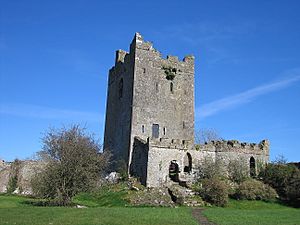Clonony facts for kids
Quick facts for kids
Clonony
Cluain Damhna
|
|
|---|---|
|
Village
|
|

Clonony Bridge (and lock) on the Grand Canal at Clonony
|
|
| Country | Ireland |
| Province | Leinster |
| County | Offaly |
| Time zone | UTC+0 (WET) |
| • Summer (DST) | UTC-1 (IST (WEST)) |
Clonony (which means Cluain Damhna Beag in Irish) is a small village in County Offaly, Ireland. It is most famous for Clonony Castle, a cool old tower house built around the year 1500.
The village is located between the River Brosna and the Grand Canal. It is part of the Gallen and Reynegh area. The closest town is Cloghan, which is about 2.8 kilometers (1.7 miles) to the south-east. The city of Athlone is about 22 kilometers (14 miles) north of Clonony.
Contents
Clonony Castle: A Historic Tower House
Clonony Castle, known as Caisleán Chluain Damhna in Irish, is a Tudor-style castle. It was built by the MacCoughlan family a long time ago.
Who Owned Clonony Castle?
The castle was given to King Henry VIII by John Óg MacCoghlan. Later, it was given to Thomas Boleyn. This happened when King Henry VIII wanted to marry Thomas's daughter, Anne.
Two of Anne Boleyn's second cousins, Mary and Elizabeth Boleyn, lived at Clonony Castle. They spent their lives there. Their tombstone can still be seen on the castle grounds. This grave was found in 1803, about 100 yards from the castle. The stone is quite large, measuring eight feet by four feet. It has an inscription that tells us who is buried there.
From 1612 to about 1620, a man named Matthew de Renzi lived in the castle. He was a cloth merchant from London, originally from Germany. Matthew de Renzi is famous for creating the first English-Irish dictionary. He got the castle after the MacCoghlans lost it during a conflict called the Nine Years' War.
What Does Clonony Castle Look Like?
Clonony Castle is a fifty-foot tall tower. It is considered an Irish National Monument, which means it's a very important historical site. The castle is surrounded by gardens and a moat, which is a ditch filled with water.
The castle has many features typical of tower houses from its time. These include a machicolation (a floor opening for dropping things on attackers) and a murder hole (another opening for defense). It also has a spiral staircase, gun-loops for firing weapons, and a garderobe (an old toilet). The ground floor used to be collapsed, but it has been fixed during recent restoration work. The second floor has a cool barrel-vaulted ceiling, which has also been restored.
The tower house has three floors. The main entrance is on the west side, with a machicolation above it. Inside, there is a fire-proof vault over the ground floor. A spiral staircase leads to the upper levels. The castle also has different types of windows, including round, ogee, and flat-headed ones.
The outer wall, called a bawn, was rebuilt in the 1800s. It has two square corner towers and an entrance that once had a coat of arms. This rebuilt bawn gives a good idea of how a tower house might have looked with its defenses.
Visiting Clonony Castle
Clonony Castle is located a few miles from Clonmacnoise, which was an important center for learning in ancient Ireland. Other nearby places include Shannon Harbour and the towns of Cloghan, Banagher, and Shannonbridge.
The castle has been greatly restored since 2010. It was put up for sale in 2022. The description said it had three bedrooms, two bathrooms, a large dining room, a study, and a 'ladies chamber'. It sits on three acres of land.
The castle is currently open to the public for free. While there are no set visiting hours, the owners try to keep it open and welcome visitors for tours.
Images for kids





